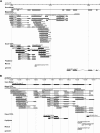Proteogenomics of Pristionchus pacificus reveals distinct proteome structure of nematode models
- PMID: 20237107
- PMCID: PMC2877580
- DOI: 10.1101/gr.103119.109
Proteogenomics of Pristionchus pacificus reveals distinct proteome structure of nematode models
Abstract
Pristionchus pacificus is a nematode model organism whose genome has recently been sequenced. To refine the genome annotation we performed transcriptome and proteome analysis and gathered comprehensive experimental information on gene expression. Transcriptome analysis on a 454 Life Sciences (Roche) FLX platform generated >700,000 expressed sequence tags (ESTs) from two normalized EST libraries, whereas proteome analysis on an LTQ-Orbitrap mass spectrometer detected >27,000 nonredundant peptide sequences from more than 4000 proteins at sub-parts-per-million (ppm) mass accuracy and a false discovery rate of <1%. Retraining of the SNAP gene prediction algorithm using the gene expression data led to a decrease in the number of previously predicted protein-coding genes from 29,000 to 24,000 and refinement of numerous gene models. The P. pacificus proteome contains a high proportion of small proteins with no known homologs in other species ("pioneer" proteins). Some of these proteins appear to be products of highly homologous genes, pointing to their common origin. We show that >50% of all pioneer genes are transcribed under standard culture conditions and that pioneer proteins significantly contribute to a unimodal distribution of predicted protein sizes in P. pacificus, which has an unusually low median size of 240 amino acids (26.8 kDa). In contrast, the predicted proteome of Caenorhabditis elegans follows a distinct bimodal protein size distribution, with significant functional differences between small and large protein populations. Combined, these results provide the first catalog of the expressed genome of P. pacificus, refinement of its genome annotation, and the first comparison of related nematode models at the proteome level.
Figures





Similar articles
-
Pristionchus.org: a genome-centric database of the nematode satellite species Pristionchus pacificus.Nucleic Acids Res. 2007 Jan;35(Database issue):D498-502. doi: 10.1093/nar/gkl804. Epub 2006 Oct 24. Nucleic Acids Res. 2007. PMID: 17062617 Free PMC article.
-
Mutation rates and intraspecific divergence of the mitochondrial genome of Pristionchus pacificus.Mol Biol Evol. 2011 Aug;28(8):2317-26. doi: 10.1093/molbev/msr057. Epub 2011 Mar 2. Mol Biol Evol. 2011. PMID: 21368317
-
Mass spectrometry at the interface of proteomics and genomics.Mol Biosyst. 2011 Feb;7(2):284-91. doi: 10.1039/c0mb00168f. Epub 2010 Oct 21. Mol Biosyst. 2011. PMID: 20967315 Review.
-
Pristionchus pacificus: a well-rounded nematode.Bioessays. 2006 Jun;28(6):651-9. doi: 10.1002/bies.20404. Bioessays. 2006. PMID: 16700067
-
Proteogenomics: needs and roles to be filled by proteomics in genome annotation.Brief Funct Genomic Proteomic. 2008 Jan;7(1):50-62. doi: 10.1093/bfgp/eln010. Epub 2008 Mar 10. Brief Funct Genomic Proteomic. 2008. PMID: 18334489 Review.
Cited by
-
First insights into the nature and evolution of antisense transcription in nematodes.BMC Evol Biol. 2016 Aug 22;16(1):165. doi: 10.1186/s12862-016-0740-y. BMC Evol Biol. 2016. PMID: 27549405 Free PMC article.
-
Global detection of protein kinase D-dependent phosphorylation events in nocodazole-treated human cells.Mol Cell Proteomics. 2012 May;11(5):160-70. doi: 10.1074/mcp.M111.016014. Epub 2012 Apr 10. Mol Cell Proteomics. 2012. PMID: 22496350 Free PMC article.
-
Comparative analysis of genomics and proteomics in Bacillus thuringiensis 4.0718.PLoS One. 2015 Mar 17;10(3):e0119065. doi: 10.1371/journal.pone.0119065. eCollection 2015. PLoS One. 2015. PMID: 25781161 Free PMC article.
-
A note on the false discovery rate of novel peptides in proteogenomics.Bioinformatics. 2015 Oct 15;31(20):3249-53. doi: 10.1093/bioinformatics/btv340. Epub 2015 Jun 14. Bioinformatics. 2015. PMID: 26076724 Free PMC article.
-
Phosphoproteome of Pristionchus pacificus provides insights into architecture of signaling networks in nematode models.Mol Cell Proteomics. 2012 Dec;11(12):1631-9. doi: 10.1074/mcp.M112.022103. Epub 2012 Aug 25. Mol Cell Proteomics. 2012. PMID: 22923814 Free PMC article.
References
-
- Alexa A, Rahnenfuhrer J, Lengauer T 2006. Improved scoring of functional groups from gene expression data by decorrelating GO graph structure. Bioinformatics 22: 1600–1607 - PubMed
-
- Ansong C, Purvine SO, Adkins JN, Lipton MS, Smith RD 2008. Proteogenomics: Needs and roles to be filled by proteomics in genome annotation. Brief Funct Genomics Proteomics 7: 50–62 - PubMed
-
- Baerenfaller K, Grossmann J, Grobei MA, Hull R, Hirsch-Hoffmann M, Yalovsky S, Zimmermann P, Grossniklaus U, Gruissem W, Baginsky S 2008. Genome-scale proteomics reveals Arabidopsis thaliana gene models and proteome dynamics. Science 320: 938–941 - PubMed
-
- Benjamini Y, Hochberg Y 1995. Controlling the false discovery rate—a practical and powerful approach to multiple testing. J R Stat Soc Ser B Methodol 57: 289–300
-
- The C. elegans Sequencing Consortium 1998. Genome sequence of the nematode C. elegans: A platform for investigating biology. Science 282: 2012–2018 - PubMed
Publication types
MeSH terms
LinkOut - more resources
Full Text Sources
Other Literature Sources
Research Materials
